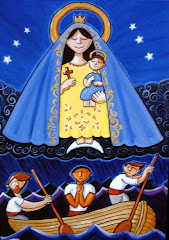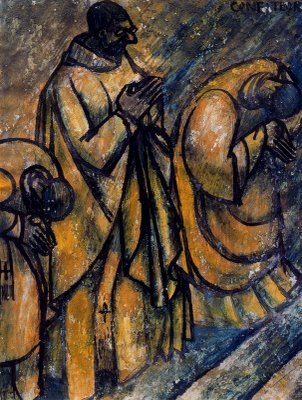
The following is a Paper published at
Rorate Caeli. It represents a
very worthwhile exploration of some of the liturgical-theological
positions proper to a correct "Traditionalist" understanding of
the situation in the life of the Church today. I present it here
for your perusal and edification.
FIUV Position Paper 2: Liturgical Piety and Participation
1. The term ‘Liturgical Piety’ refers to a piety which is fostered by frequent participation in the liturgy, draws inspiration from the unfolding of the sacred mysteries through the cycle of the liturgical year, and for which the texts of the liturgical books and the ceremonies of the liturgical rites as central rather than peripheral to its formation. It is contrasted with a piety which is formed predominantly by non-liturgical devotions, whether these be public or private. The fostering of liturgical piety, and the participation in the liturgy conducive to such piety, might be said to be the ultimate objects of the Liturgical Movement, from its beginnings in the nineteenth century up to, and including, the influence that Movement had on the reform of the liturgy after the Second Vatican Council. It was the task of successive popes to encourage this movement while simultaneously guarding against the exaggerated and misguided conclusions which were sometimes derived from this ideal. The concept of liturgical piety is of particular interest in the context of the Extraordinary Form of the Roman Missal, since this ideal continues to influence discussion of the participation of the faithful in the liturgy, and the discussion of how the Extraordinary Form should be celebrated, and its liturgical books further developed over time. In particular this paper is intended to shed light on the question of whether the ‘former liturgical tradition’ is itself a barrier to a proper liturgical participation by the faithful, and whether the arguments of the Liturgical Movement, and the contemporary Magisterium such as Pius XII’s encyclical Mediator Dei, should be read as indicating that it is a barrier.
2. The desire for a more liturgical piety arose naturally from two observations. First, that the Catholic liturgy is an enormously rich source for the devotional life. As the English Cardinal Wiseman exclaimed as early as 1842:
Why there is not a place, or a thing, used in the worship which [the Catholic] attends, upon which there has not been lavished, so to speak, more rich poetry and more solemn prayers, than all our modern books put together.
3. Secondly, the liturgy, and in particular the Eucharist, is of its very nature the privileged opportunity for the Christian to communicate with God. The liturgy is the public prayer of the Church, and the Mass is the re-presentation of Christ’s Sacrifice on the Cross: in joining themselves to the first, the faithful can take part in the perfect prayer offered to God by His spotless Bride; in joining themselves to the second, the faithful can associate their own offerings with the perfect Sacrifice offered to the Father, that of the spotless Victim.
4. For the liturgy to have the place in the ordinary Catholic’s devotional life which it ought to have, his participation in the liturgy must be as profound as possible. One way of fostering this was to promote liturgical formation, both of the clergy and the faithful, notably by books, both of the liturgy—missals for the laity—and about the liturgy, such as Dom Prosper Guéranger’s monumental ‘L’Année liturgique’, published between 1841 and 1844. Guéranger wrote in his general preface, after noting the special value of prayer united with the Prayer of the Church:
Liturgical prayer would soon become powerless were the faithful not to take a real share in it, or, at least, not to associate themselves to it in heart. It can heal the world, but only on the condition that it be understood.
5. Even at its very dawn, the aims and inspiration of the Liturgical Movement encompassed a tension. On the one hand, the richness, which is to say the theological profundity, density, and complexity of the Catholic liturgy, is part of the reason for promoting a greater appreciation of it, particularly as the basis for devotional contemplation. On the other hand, if participation in the liturgy, which was also recommended by the contemporary Magisterium, requires an adequate understanding of it, then it would seem that participation could be enhanced both by the exposure to view of parts of the liturgy traditionally hidden, in one way or another (by saying silent prayers aloud, by the use of the vernacular, by saying Mass ‘versus populum’), and also by the simplification of the rites.
6. This tension explains the debate within the Liturgical Movement over liturgical reform, which continued for more than a century. Many writers in the movement were profoundly attached to the liturgy as it had been handed down, and opposed (for example) the use of the vernacular: Guéranger himself being an example of this. Others took the opposite view.
7. This tension can be resolved, however, by two observations. First and most simply, taken to its logical conclusion, the attempt to ease the comprehension of a rite by simplifying it is self-defeating, since the process of simplification has the result that there is less to comprehend. Removing prayers and ceremonies, clearly, removes things which could be the object of fruitful meditation.
8. Secondly, the ‘comprehension’ at issue in liturgical participation is not primarily a matter of the grasp of propositions; it concerns rather the spiritual impact of the liturgy on the participant. Fr Aidan Nichols OP, discussing the views of a number of sociologists concerned with religious ritual, observes:
To the sociologist, it is by no means self-evident that brief, clear rites have greater transformative potential than complex, abundant, lavish, rich, long rites, furnished with elaborate ceremonial.
Again:
The notion that the more intelligible the sign, the more effectively it will enter the lives of the faithful is implausible to the sociological imagination. ...a certain opacity is essential to symbolic action in the sociologists’ account…
9. This is not just a matter of aesthetic impact, but of the general issue of non-verbal communication. Elaborate ceremonial indicates in a universal language the importance of whatever is at the centre of the ceremony. The use of Latin serves to emphasise the antiquity and universality of the liturgy, as Pope Blessed John XXIII pointed out. The use of silence is a very effective means of emphasising the sacred character of what is happening. Similar things can be said of many aspects of the former liturgical tradition which might superficially appear to impede the comprehension of the faithful. Pope Blessed John-Paul II refers to such things in speaking of the liturgy of the Oriental Churches:
The lengthy duration of the celebrations, the repeated invocations, everything expresses gradual identification with the mystery celebrated with one’s whole person.
Again, as the Instruction Liturgiam authenticam points out:
The Sacred Liturgy engages not only man’s intellect, but the whole person, who is the “subject” of full and conscious participation in the liturgical celebration.
10. The point is underlined by Pope Pius XII’s encyclical Mediator Dei. While approving a number of the initiatives of followers of the Liturgical Movement, as well as deprecating others, he makes an important qualification.
Many of the faithful are unable to use the Roman missal even though it is written in the vernacular; nor are all capable of understanding correctly the liturgical rites and formulas. So varied and diverse are men’s talents and characters that it is impossible for all to be moved and attracted to the same extent by community prayers, hymns and liturgical services. Moreover, the needs and inclinations of all are not the same, nor are they always constant in the same individual. Who, then, would say, on account of such a prejudice, that all these Christians cannot participate in the Mass nor share its fruits? On the contrary, they can adopt some other method which proves easier for certain people; for instance, they can lovingly meditate on the mysteries of Jesus Christ or perform other exercises of piety or recite prayers which, though they differ from the sacred rites, are still essentially in harmony with them.
11. With the aid of this fuller understanding of participation, which is certainly both active and liturgical, but which is of the whole person, and not merely the intellect, we can look again at the questions raised by the Liturgical Movement about the form that a properly liturgical piety should take. To be imbued with the spirit of the liturgy, to have the liturgy in its proper place of honour in one’s spiritual life, requires a degree of liturgical catechesis, but it is above all to be effected in the way the Church, in the liturgy, wishes us to be effected. This is with a profound sense of awe, awe being the rational response to the apprehension of the Holy. It is this sense which stimulates us to participate spiritually in the Sacrifice as intensely as possible. Pope Benedict XVI has noted that a particular charism of the Extraordinary Form in its ‘sacrality’, its evocation of awe. The mysteriousness of the ceremonies, the fact that prayers are said in a sacred language, even silently, the fact that parts of the liturgy are veiled from sight, naturally contribute to that awe, and in this way facilitate, rather than impede, the participation of the faithful.






